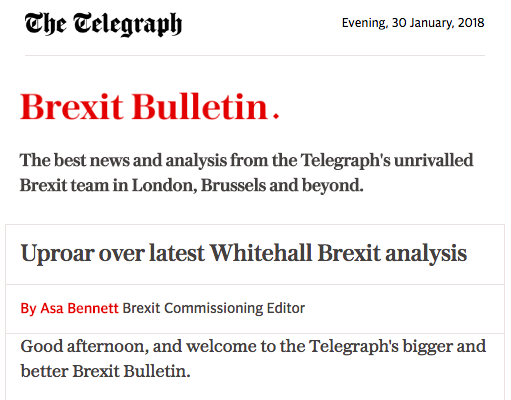
A key priority of The Daily Telegraph's digital strategy is to grow the number of registered users accessing the site, and one of the pillars supporting this initiative is a new and improved approach to email newsletters.
The publisher launched six editorial newsletters over a period of six weeks, in a drive to refresh its newsletter strategy, previously a medium primarily used by commercial teams, explained Dan Silver, head of digital publishing at The Telegraph.
“We talk very much here about drawing the distinction between promotional newsletters and editorial newsletters, promotional ones being much more based around ROI and generating leads,” Silver told Journalism.co.uk in a recent podcast.
“Editorial newsletters we consider to be stand alone pieces of editorial content, either written or curated for an audience, full of authored analysis.”
The strategy doesn’t rely on readers clicking on links to get back to the Telegraph website, with the team having a relaxed approach about whether a reader clicks back through to the website or ends their involvement with the newsletter once they have finished reading.
The six newsletters were born with this approach in mind: Front Bench, the morning political email; Brexit Bulletin, an afternoon political newsletter focused on Brexit; three rugby newsletters called Rugby Reader, Rugby Nerd and Geech on Friday; and a revamped technology newsletter, Technology Intelligence.
“One of the key benefits for us as publishers is that newsletters allow us to speak directly to our most engaged audience, which is really important in this age of variable algorithms and search engines and social platforms. Having that direct relationship with readers is really important.”
The newsletters are built around personalities and many heavily feature “authored analysis”. Front Bench is authored by Daniel Capurro, who works on The Telegraph comment desk, and The Brexit Bulletin is authored by a roster of Telegraph political journalists, including Asa Bennet.

They use an informal tone of voice, but one that still has authority and is matched to the Telegraph brand.
“One of the key editorial principles we're trying to introduce is this idea of authored analysis, so taking a reader behind the headline. Not just letting them know something has happened but letting them know why it's happened and letting them known The Telegraph's take on that, explained Silver.
“So if you subscribe to our politics newsletters you'll notice we're very relaxed about covering stories from rival publications and we'll quite happily link back to those rival publications.
“We'll give you the story, and we'll give you The Telegraph's take on why we think it matters, so hopefully the reader will have enough in that newsletter that they feel like they're satiated on that story, but if they want to go back to the original source, we're more than happy.”
The team has also experimented with getting newsletter readers involved with the content, for example running polls in the morning politics newsletter, with answers then published in the afternoon Brexit Bulletin.
“If you think about it, [newsletters are] very mobile friendly, they're in a format that users are very familiar with, and they really help cut through that information overload that exists everywhere else if they're done properly.
“The best newsletters take you beyond the headlines and give you the context around the stories. For users, there's a huge benefit and it would be very remiss of publishers not to tap into that,” Silver said.
Listen to the full podcast here.
Free daily newsletter
If you like our news and feature articles, you can sign up to receive our free daily (Mon-Fri) email newsletter (mobile friendly).









